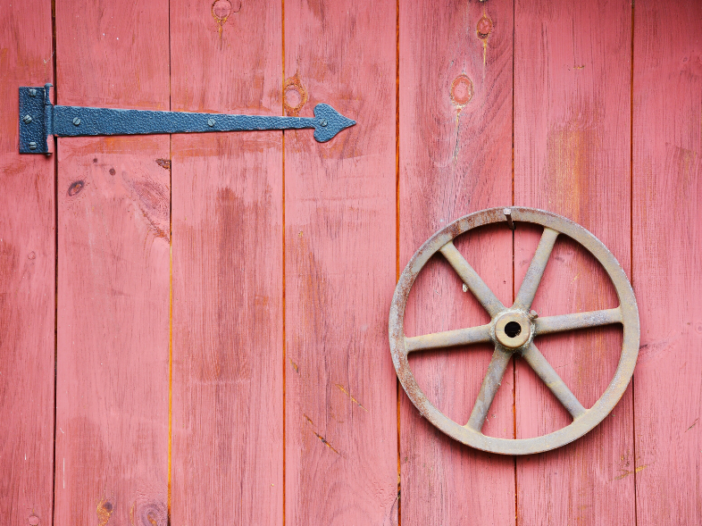
Lessons From a Hinge: Change is Possible
By: Ginger Morgan
Let’s face it: our lives are not perfect. We may have a lot of things going right. (We should celebrate that!) Those are the things we can be grateful for. On the other hand, there are other areas of our lives that we may NOT be satisfied with: things that get us down or feel like areas of our lives that are “under construction.” Whenever we think about how to improve those things, we discover that sometimes change feels really hard.
American culture is famous for New Year’s resolutions. Maybe you’ve done that, making formal, written resolutions or privately you say to yourself, “this year I’ll do better.” In general, I am a fan of setting clear and positive intentions for our lives. That said, New Year’s Resolutions can be a defeating experience if we don’t achieve the changes we hoped for. Anyone who has worked at losing weight may have had some success only to find old eating habits creep back. Maybe you know what it’s like to have anxiety take over your body and brain, or you feel down or depressed and don’t really know why. Just because we want things to change doesn’t make it happen.
That’s why it is important to understand how and why we can make changes that stick ~ so we aren’t stuck thinking things will never change. I heard a phrase recently that stuck so much in my mind I want to share it with you. It can help explain how to think about making change happen:
Small hinges swing big doors.
Now, I want you to close your eyes and think about a big barn door (even if you are from the city, you’ve likely seen a barn in a movie, if not at some point in person). You know, the big panel doors that are twice as tall as a person and swing open to let a tractor in or out? Those big doors likely have 2 or 3 small hinges. Small hinges swing big doors.
I take this to mean that sometimes just a small change can make a big difference. Several years ago a friend and I set out to hike to the summit of a 14,000 foot mountain peak near Buena Vista, Colorado (Mt. Yale—one of the mountains in the Collegiate Peaks range). My friend had done this before, but this was my first “fourteener.” So, because I was a bit of a newbie the trek took us longer than my friend had estimated (she could have made it up in far less time than I could manage). There are three memories from this trip that relate to this idea of change.
First Memory During the hike, somewhere between leaving treeline and getting to the top, I was absolutely sure I couldn’t make it to the top. I felt sick. I was tired. Every time I kept looking up to the top of the mountain I felt totally overwhelmed. My friend very gently would point to a boulder a bit above and ahead of us and say: “do you think you can walk to that boulder, right up there?” I’d look up and see a distance I thought I could walk. I’d answer, “yes, I think I can make it to that boulder.” Then, we’d walk to the boulder. I’d sit. I’d look at the top. Be absolutely sure I was done. She would give me some trail mix or a granola bar. I’d drink some water. We’d look around at the mountain lakes below us, or the alpine flowers or look for marmots. Then, she’d casually glance up ahead and very easily ask, “do you think you can make it up to that curve in the trail?” And so it went. Bit by bit. I did finally make it up the mountain. Lesson #1: set your sights on something you think you can do; small success is better than no success.
Second Memory I am glad I got to the top. It was worth the struggle in the end. The view from and experience of standing LITERALLY on top of a part of the earth was awe-inspiring. It was vast and clouds were below us and we could see forever and yet were standing on the ground. And…I had WALKED UP THAT MOUNTAIN! (That’s a great feeling!) But, do you know what? I also remember the view from the boulder field when we stopped so I could rest. I remember walking on the pine needles in the forest before we even hit the treeline. I remember looking at the mountain lakes and watching the marmots and discovering the tiny alpine flowers. Mostly, I think of what I learned about my friend that day. I would never have known how skillfully and graciously she could invite me forward, conveying both care and confidence without one iota of impatience or judgment or frustration if I hadn’t struggled so much. If getting to the top had been her only goal or my only goal, we would have missed so much (and probably never made it there). Sometimes, thinking too hard about the destination we miss noticing beauty and kindness and small achievements all along the way. Lesson #2: Change is both a process and a destination. Mostly, though, it’s a process. Try to enjoy it along the way.
Third Memory By the time we summited the peak we were into the afternoon hours. My friend eventually got worried we were going to run out of daylight before we were off the mountain. So, we started our descent. Having walked along a ridge at the peak, we took a slightly different heading off the peak than we took coming up the mountain. We realized as we hit the forest that we were not on the same trail we’d come in on. As evening started to fall and light faded, walking through the forest got more and more difficult. We were run-walking our way out hoping to avoid walking through the forest in the dark. By the time we made it down and off the trail (after sunset, but before full on darkness) we discovered we were several MILES from where we had left the car… We made a very small direction change at the top of the mountain. By the bottom, that small angle change delivered us a LONG way from where we started. Lesson #3: Sometimes a very small adjustment can help us move toward a very big change.
To Recap:
1. Start with small achievable goals.
2. Try to enjoy things along the way and celebrate the small successes.
3. Small adjustments can lead to big changes in the end.
Because… small hinges swing big doors.
Written by Ginger Morgan, PhD
Director of Candid–Health and Life Coach
